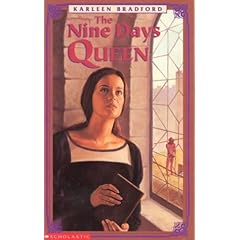I too became interested in history through more popular means than my 'Integrated Studies' classes of grades seven and eight (and yes, for some reason geography and history were lumped together under that unappealing name). Something about fur-traders and the plaines d'Abraham just didn't peak my interest. But I read many historical novels for 'tweens' - or whatever we were called back then - and I thought I would share some of my favourites.

Karleen Bradford, The Nine Days Queen
I loved this book when I read it. It got me completely interested in Henry VIII and his wives. The book revolves around the short life of Jane Grey, whose mother was first cousin to Henry. When Henry's son, King Edward VI dies, a Protestant faction puts her unwillingly on the throne for nine days, until she is unceremoniously thrown in the Tower of London by the true queen, Mary I. Later she is beheaded. The fact that it was a true story made it such an exciting book, and it had everything: royalty, Renaissance England, murder, sex scandals. Young readers will be completely engrossed by the fact that Jane is only a few years older than them.

The Diary of Anne Frank
Though not a novel, this is a must-read for anyone young person, even if they're not interested in history. It is an incredibly powerful book and will give any young person a real glimpse into the horrors of WWII (I doubt I'm spoiling anything when I say that everyone except her father dies in concentration camps). Anne is a great narrator, however, sharing every personal detail of her life hiding from the Nazis - how she hates her parents, when she got her period, even how she has a crush on the boy they live with. Incredibly poignant, and a great introduction for kids interested in learning about WWII.

Ruth Park, Playing Beatie Bow
I read this book in school, and good thing I did. It really is one of my favourite children's books of all time. I was slightly obsessed with time travel books, and this book is a great example of the genre done well. Unhappy Abigail is intrigued by a game played by some kids in the park called Beatie Bow, and her search (as well as a piece of Victorian lace she has just bought) leads her to travel back to 19th century Sydney. I loved time travel books because it let the reader see very clearly the differences in past and modern life, and the modern narrator's comments were always the same as my own. It let you imagine what you, the reader, would do in the same situation. Abigail discovers new friends, a new life, grows up a bit and learns to appreciate what she has. Sounds simple, but it works.

Kit Pearson, The Daring Game
Okay, so this one isn't too historical, though it is set in the 1960s. I just had to put a Kit Pearson book on this list because she's such a great children's writer, and I loved all her books. This is her first one, and it's a great story about a girl who moves to a boarding school, and gets into some fun/trouble with a game played by her roommates. Pearson also wrote a fabulous time travel book called A Handful of Time, where an unhappy girl accidentally goes back in time to when her mother was young while she's at a family cottage. She's well-known for her Guests of War trilogy about English children who come to Canada to escape the war.
History will always be in the popular imagination, and as long as authors and directors find new ways of bringing it to life, kids will gain an interest in history that might even translate to a life-long hobby or even further study. I find it hard to believe that kids can't get excited about history when it is so prevalent in novels, movies, even video games. It's true that history classes in school can be dry and unimpressive, but hopefully kids can discover the wealth of popular history that is out there, like I, and most likely many of my history grad colleagues, did.